#metaphor
Text
The Suit-Making Metaphor
[Written in January, 2024]
The cold eventually got bad enough that the Grandma, the kids and I fled to a hotel while Matt stayed at the house with the dogs. We were fortunate to be able to that of course, and sharing a room in a nice warm hotel was not suffering by any stretch of the imagination. Even so, it was stressful. We brought ipads, paints, books and needlework to keep the kids entertained and alleviate some anxiety, but time also had to be made for school work—especially as they would be going back to class just in time for finals. We made lists of their classes, what they had to study, what we could help with and what questions would need to be put to their teachers.
Henry’s 16 now (!!) and instead of an exam, his Humanities final was a personal essay. We chatted a bit about his writing process, what he liked about what he had done so far and what was frustrating for him. Though he had a terrific topic, he’d written and rewritten his opening paragraph several times and wasn’t making any real progress.
Been there, buddy.
As we talked, I stumbled on a metaphor that I found helpful, and so I’m going to try and share with you roughly what I said to him, and perhaps some of you will find it helpful too.
I get it, I do. It’s exactly my inclination as well. But writing like this-- where you try to perfect everything as you go, effectively writing the third draft before you finish the first--it’s like trying to make a suit from the top to the bottom.
You can’t make a suit like that. You can’t start with the collar and get that perfected and then move to the shoulder. You can’t topstitch the upper part of the button placket before the bottom even exists. And even if you could figure how to do it that way, your suit isn't going to fit. Because that’s just not the best way to make a suit.
Finishing the thing from top to bottom is not the best way to write, either.
You start by choosing your fabric—your topic. What material are you going to craft the suit from? What’s the subject of the essay?
You want to write about your relationship to various monsters. That’s terrific! That’s like a nice wool; there’s heft there—memories and feelings and personal details that resonate as truths; it should make a rich and interesting suit.
Now, instead of cutting out the collar immediately, let’s choose a pattern. We need a pattern to help us cut the wool into the proper shapes. The pattern is the very basic structure of your essay. How might you organize your thoughts and feelings about monsters? The order isn’t as important as the categories. For the suit jacket, we’ll need right front, left front, sleeves, collar, lining etc. For the essay, what monsters do you want to write about?
King Kong, the Rancor, the Minotaur and Bernard the Bull. Perfect.
Cutting the pattern pieces out is equivalent to gathering your thoughts on each monster. Write freely about each one, taking the time to remember in as much detail as possible where you first encountered each monster, how old you were, etc. Go through each of your senses to help you recall the moment. What did you see? Smell? Taste? Feel? Who was with you? How did you feel in your body? How did you feel in your heart? Include everything that jumps out at you, you can always edit it down later. In our metaphor, this step is not just cutting out the pieces but also taking the time to transfer the pattern marks. You might not need them all, but you're sure to make a finer suit if you have them all available.
Once you have the pieces, the next step is to see how they fit together. Read through each monster and look for connections. Is there an order that suggests itself? Rearrange and then edit and expand to highlight those connections. The first pass of this is basting stitches—loose connections just to test the fit—once you’re happy with the shape you can go ahead and lay in seams.
Here is where our parallels start to fall apart:
For the suit, you’ll want to do all the finishing touches—the handstitching, buttons, pressing, etc.—and then try it on and style it.
But in writing your essay, these steps are reversed—styling is crafting the last paragraph, bringing the piece to a close. Your essay doesn’t have to wrap up neatly, in fact, you don’t want it to be too matchy-matchy. Just as an outfit’s style is improved by personal idiosyncrasies, a piece of writing is enriched by the author's capacity to engage with complexity and ambiguity.
With the styling done--when you really know what it is you're trying to say--now you can go back with needle and thread and do that hand-stitching: tighten the prose where you can, polish rhythms, word choice, grammar and voice. With the whole of the thing in front of you, you now have what you need to do the kind of “third draft” finishing work that was impossible to begin with.
This might be the very definition of beating a metaphor to death, but I surprised myself with it. It was as revelatory for me as it was for Henry--probably more so.
And with that, I need to get back to those now-422 emails.
Cheers,
Kelly Sue
PS New creator-owned book coming out late fall this year--first launch in a decade or so, I think? I do need to figure out this whole newsletter/blog conundrum sooner rather than later. Advice and opinions welcome.
125 notes
·
View notes
Text
The Mirror Metaphor Used In Tangled
Mirrors are an important narrative device all throughout the film, one of the first times we see a mirror on screen is when Rapunzel is a child.

We see a young Rapunzel sneaking out of her room to look at the floating lanterns, this specific mirror merely helps us understand how vain Gothel is. The mirror is reflecting back Rapunzel, and as the movie continues, a mirror reflecting Rapunzel represents a time where she is under Gothel's control.
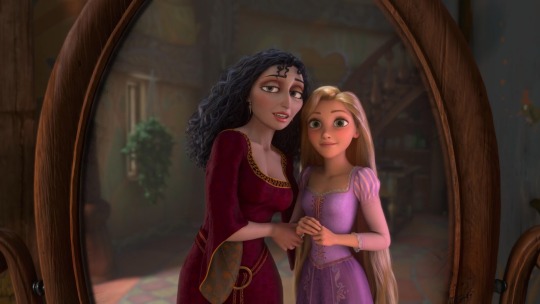
During this scene we get our first introduction the The Mirror, the one that is primarily used for this metaphor. The Mirror shows the viewer the relationship between Gothel and Rapunzel. Here, Gothel says,
"Rapunzel, look in that mirror. You know what I see? I see a strong, confident, beautiful young lady. Oh, look, you’re here too!”
This scene is not only Gothel tearing down Rapunzel, but it gives us a direct connection between Gothel, The Mirror, and Gothel's desire to remain young forever. It shows us how Gothel views Rapunzel, how she views her only as a device to remain young, not as a daughter.
It shows us the control Gothel has over Rapunzel, as Rapunzel does not stand up for herself or even question this behavior.
In the Mother Knows Best scene The Mirror makes another appearance.

Gothel forces The Mirror in front of Rapunzel after describing all the reasons why Rapunzel can never leave the tower, after making Rapunzel feel naïve and dumb for believing she ever could survive in the real world.
The Mirror is used often to distort or only show fragments of the truth.
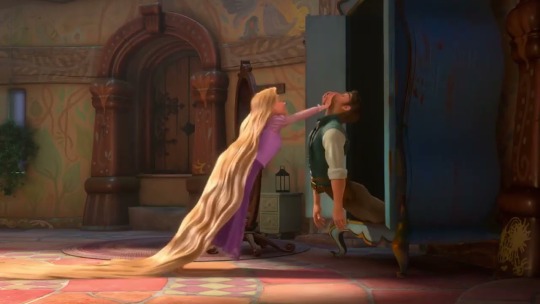
When Rapunzel begins to trap Flynn in the closet, The Mirror is facing away from her/the act.
The after she...secures him in...she accidentally knocks The Mirror towards her.
Following this, she finds the crown due to it's reflection in The Mirror, which she then goes to try on. She has a moment where she feels confident again, forgetting Gothel's doubts, even if it's just for a moment.
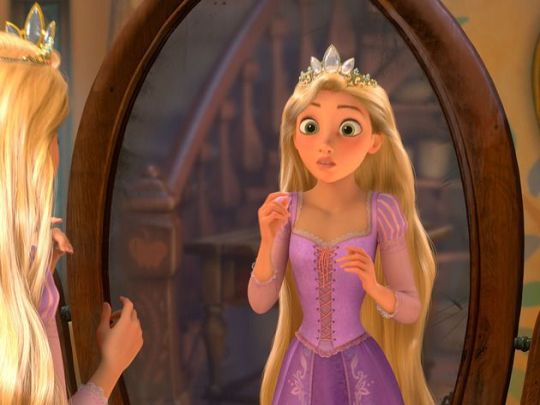
After Rapunzel has this moment, Gothel returns to the tower. This causes Rapunzel to fumble around knocking The Mirror as she hides the crown, causing The Mirror to spin around, now facing fully away from Rapunzel/the tower.
The moment is key, because this shows us Rapunzel now has a new goal. One that doesn't include Gothel's agreement. One that threatens Gothel's control.
After this, Rapunzel and Flynn escape the tower and we don't see The Mirror again until Gothel returns to find Rapunzel missing.

We see The Mirror for a brief moment, as Gothel hasn't yet realized she's lost control over Rapunzel.
When Gothel finishes inspecting the tower, The Mirror is gone.

This shows Gothel's loss of control, and the break in Gothel and Rapunzel's relationship.
In the end, after Gothel has manipulated Rapunzel back into her control, Rapunzel begins to have her realization/deja vu moment. When she realizes she is the lost princess, The Mirror reappears. Now showing a blurred reality outside of the frame.
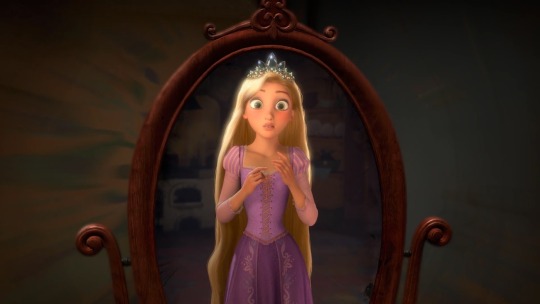
In the final confrontation, Rapunzel rejects Gothel's attempts to touch her hair. Causing Gothel to stumble backwards, knocking over and shattering The Mirror.

Gothel and Rapunzel's relationship is broken. Gothel's control over Rapunzel is broken.
As we all know, Flynn then proceeds to use a piece of this shattered glass to cut off Rapunzel's hair. Gothel immediately begins to grow old, her death imminent.
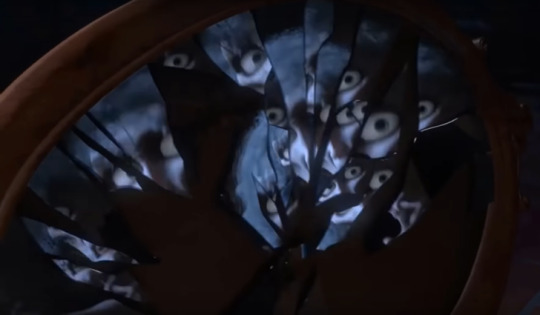
Gothel desperately stares into the shattered remains of The Mirror, showing the shattered pieces of Gothel and Rapunzel's relationship as well as the control Gothel once had over Rapunzel.
I have more metaphors I'd love to talk about, another favorite of mine is the use of light throughout Tangled. So expect another unnecessarily long post soon!
65 notes
·
View notes
Text
"I have lost you longer than I have had you," she said—
I stood there oblivious and numb to the pain. I felt her words like a punch to the gut, like knives cutting deep.
The air was thick with tension as we stood there, the silence between us threatened to consume us.
Until a wave of shame washed over me, lingering on my soul.
My mouth went dry of words as realization dawned on me:
I had become what I avoided
And she saw it too.
source: @chaosmindthoughts
#writing#thoughts#venting#quotes#love#poetry#her#wlw#light academia#dark acamedia#bookblr#paradox#metaphor#breakup#hurtful#fears#fragments#spilled feelings#spilled ink#spilled thoughts#spilled words#spilled poetry#spilled writing#poetryportal#writerscreed#artists on tumblr#creative writing#inspiration#inspiring quotes#souls
23 notes
·
View notes
Text
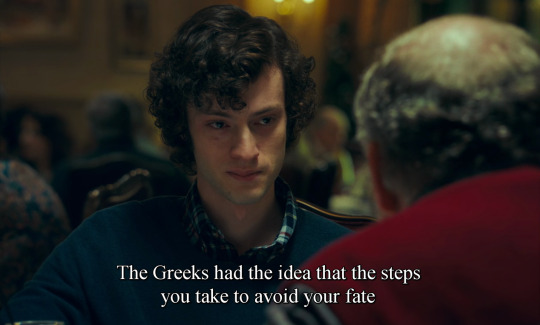
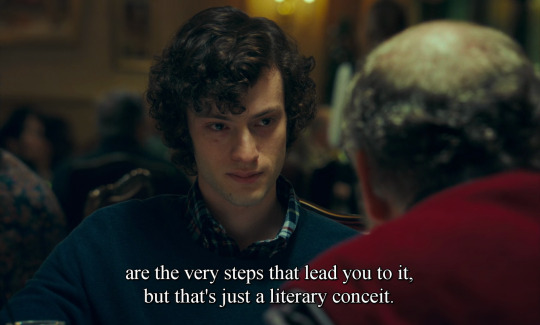
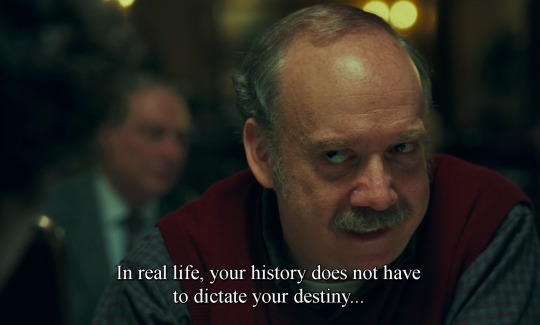
The Holdovers (Alexander Payne, 2023)
#The Holdovers#Alexander Payne#Paul Giamatti#2023#quote#Dominic Sessa#destiny#metaphor#life#freedom#philosophy
2K notes
·
View notes
Text

Never posted this on here its pretty old
#dead plate#dead plate vincent#dead plate game#vincent dead plate#rody dead plate#rody x vincent#love metaphor#metaphor
1K notes
·
View notes
Text
One of my favorite things about learning about traditional textiles is the little ghosts they left in the language. Of course the ghosts are there, now that I know to look for them. Once upon a time, half the population spent a majority of their day making textiles. Spinning, at the very least, has been a part of humanity since the Neanderthals. That kind of knowledge doesn't just disappear.
A heckle was a device with sharp metal spikes, and people drag flax through the spikes to separate out the fibers from the chaff. When you say someone heckled a performer, you think you are being literal but you're speaking in an ancient metaphor.
When my grandpa says "spinning yarns" to mean telling stories, he knows that one's not quite literal, but its vividness is lost to him. There is no image in his mind of rhythm, muscle memory, and the subtle twist that aligns clouds of fibers into a single, strong cord.
When a fanfic writer describes someone carding their fingers through someone's hair, that's the most discordant in my mind. Carding is rough, and quick, and sometimes messy (my wool is full of debris, even after lots of washing). The teeth of my cards are densely packed and scratchy. But maybe that's my error, not the writer's. Before cards were invented, wool was combed with wide-toothed combs, and sometimes, in point of fact, with fingers. The verb "to card" (from Middle English) may actually be older than the tools I use, archaic as they are. And I say may, because I can't find a definitive history. People forget, even when the language remembers.
20K notes
·
View notes
Text
I don't like sushi. I don't want to eat sushi. But you don't hear me DENYING that sushi EXISTS. I've never told someone that likes sushi that their INDOCTRINATING people into liking sushi. You won't catch me SLAPPING sushi out of someone's hand and telling them not to eat it. So don't do that with lgbtq+ ppl, okay? =]
921 notes
·
View notes
Text
Here's some silly little metaphors that I think the dragon tribes would use
SkyWings
“Don’t count your clutch before they hatch.” (Don't plan too much too soon)
“Gold is better than silver, but silver is better than nothing.” (If you can't do it perfectly, still try your best. Most dragons forget the second part.)
“‘Sorry’ can't suck the fire back in.” (The damage is done and now you're dead to me.)
“You been eating too much burnt meat or something?” (Are you nuts?)
“Stop all this smoke and use your fire.” (Stop rambling and get to the point already; or stop complaining and do something)
“Doesn't know his tail from his wings.” (Stupid or clumsy)
“You fly like a depressed pigeon.” (Slow flier)
“There's no fire in a rainstorm.” (Stop feeling sorry for yourself and get to work.)
“Nighttime is for the NightWings.” (What are you doing up? Go to sleep.)
SandWings
“She’s all rattle, and no strike.” (Like all bark no bite)
“A diamond in a pile of quartz.” (Like a needle in a haystack)
“You’re watering the cactus and ignoring the sapling.” (You’re focusing on the wrong thing; barking up the wrong tree)
“Everyone thinks the camel looks silly until the dry season comes.” (Don't listen to them, they don't know how unique and strong you are)
MudWings
“Crocodile tears.” (Fake crying in order to gain sympathy)
“You can only catch a trout if your mouth is open.” (Be open to new experiences)
“If the tree gives away too much, it ends up as a stump.” (Don't let people take advantage of your generosity)
SeaWings
“Happy as a clam in high water.” (Very happy)
“The flying fish feels like a fool when it sees an osprey.” (Don't compare yourself to others, run your own race.)
“Plenty of fish in the sea.” (Plenty more opportunities to come.)
“You’ve got ink in your eyes.” (You're blind to something important)
“Lobsters only die when they don't leave their shell.” (Keep yourself busy with new experiences and you'll life a long life)
NightWings
“Sleep is for the dead.” (Why waste your time sleeping when you could be productive)
“SeaWings know their fish and SandWings know their cactuses, but we NightWings know everything else.”(NightWing supremacy propaganda)
“Being nice to a deer never got one in my mouth.” (Other dragons don't matter, only your goals.)
“A prophecy always comes true.” (I told you so but more cryptic)
"You're counting the stars." (You're doing something tedious towards an unachievable goal)
RainWings
“Gray’s her favorite color.” (She's a huge bummer)
“A lemon is yellow on the outside, doesn't mean they're not sour.” (Referring to someone who is two faced or fake)
“I love honey, but I’d rather not get stung by the bees.” (I could do this, but it requires effort so I don't wanna)
“Nobody likes a rotten banana.” (Nobody likes a bummer/downer)
“Don't tie your tail in a knot” (don't get all upset)
“I have all my berries in a basket” (I have everything sorted out)
“You couldn't sneak up on a pineapple” (insult to one's camouflage skills, popular among children)
IceWings
“The seal who asks why the orca is chasing him is the first to get eaten.” (A favorite of parents telling their kids to shut up)
“Not the sharpest icicle on the roof” (kinda stupid or slow)
“Clear as polished ice” (i understand or see it very well)
“You're looking a little pink in the face” (you look sickly. IceWings can turn pink from eating too much krill; a symptom of malnutrition. This line can be applied to any illness.)
“Blue blood kills, red blood spills.” (Patriotic propaganda implying that IceWings win every fight
“The SkyWings toss their blue eyed hatchlings because they're worried they'll be as strong as an IceWing.” (More propaganda)
HiveWings
“Pretty is for the SilkWings.” (Vanity is stupid and impractical)
“If it buzzes like a bug and bites like a bug, it's a bug.” (Don't ignore the obvious)
“Clearsight works in mysterious ways.” (I don't know the answer to your question, now go away)
SilkWings
“It's not always good to know how the honey gets made.” (Don't stick your snout where it doesn't belong)
“She's got a couple of threads loose.” (Calling someone a little crazy, threads refers to weaving)
“The bee minds its flowers and the spider minds her silk, it's when they mix that bad things happen.” (Mind ya business)
LeafWings
“Flytraps only trap because the soil doesn't feed them.” (Dragons don't get angry out of nowhere)
“Looking like a leaf only hides you in the forest.” (Time and place)
“If a branch doesn't bend, it breaks.” (Be flexible)
“Even the corpse flower attracts the flies.” (Even someone who seems ugly to one dragon they can seem irresistible to another)
1K notes
·
View notes
Text

Poverty
1K notes
·
View notes
Photo
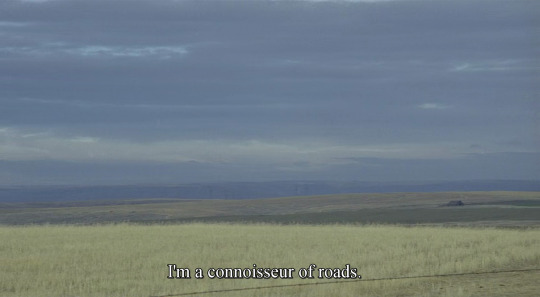



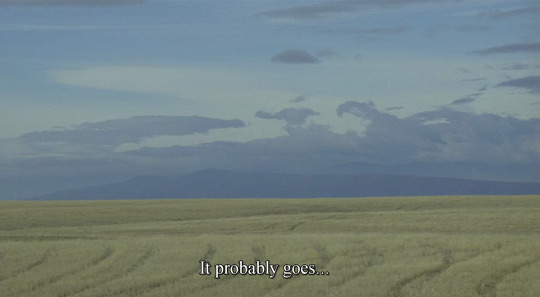
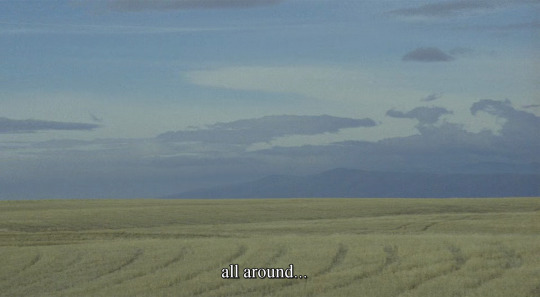
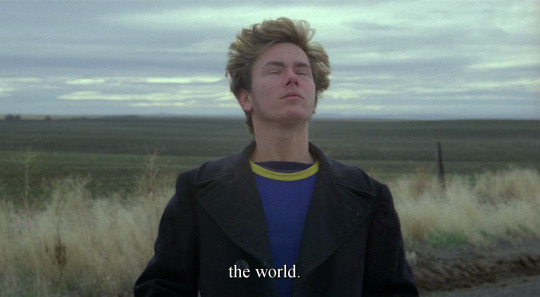
My Own Private Idaho (Gus Van Sant, 1991)
#My Own Private Idaho#Gus Van Sant#River Phoenix#quote#world#road#roads#metaphor#final scene sleep#1991#end#ending#life
4K notes
·
View notes
Text
“food as metaphor for love” this “food as metaphor for love” that when do we get HUNGER as a metaphor for yearning and aching for affection
#hannibal#hannigram#bones and all#yellowjackets#jackieshauna#ethel cain#can’t think of other examples rn#but#i know they exist#writing#metaphor
2K notes
·
View notes
Text
Everyone always talks about how much they love cannibalism as a metaphor for intense love and intimacy but the moment I bring up necrophilia I get stones thrown at me.
827 notes
·
View notes
Text

does this make sense lol
#aesthetic#coquette#girl interupted syndrome#girlcore#hell is a teenage girl#lizzy grant#girlhood#sofia coppola#girlblogger#girlblogging#pomegranate#poetry#quotes#symbolism#metaphor#lana del rey#gaslight gatekeep girlblog#this is a girlblog#girlblog aesthetic
419 notes
·
View notes
Text

Roselysne, 1975. Helmut Newton.
Gelatin silver print.
347 notes
·
View notes
Text

04/26/2024
It's a metaphor!
What's a meta for?
Nothin! What's a meta for you!
*wheezes for six minutes straight without taking a breath*
___
JOKE-OGRAPHY:
1. In this Bible story, Jesus describes Himself as a vine (like a grapevine), and His disciples as its branches. Branches can only bear fruit while connected to the main vine. If their connection is severed or tainted, they wither and die, and then they're pruned, suitable only for being tossed in a fire. Jesus is warning His disciples that their mission's fruitfulness depends on their continued, dedicated, healthy connection with Him and His Father.
2. In this cartoon, after hearing Jesus's metaphor, Peter declares that he and the other apostles (the "branches" in Jesus's metaphor) will "stick" with the vine. A "stick" is a long, thin piece of wood (like a branch), but "stick" can also mean "stay connected to." This is an inferior pun, because while the word "stick" has the two above meanings, only one of those meanings makes grammatical sense in Peter's comment (the latter).
3. Jesus replies that the vine (Him, in the metaphor) will be "rooting" for them. "Rooting" can either mean "laying down roots" (as in a tree growing its roots into the ground), or "cheering on" (like an audience cheering for a sports team). This is a superior pun to Peter's, because both meanings make grammatical sense in Jesus's comment. His declaration can be taken to mean either (1) that, as the vine, He'll provide the apostles with roots to nourish their fruitfulness, or (2) that, as their teacher, friend, and Lord, He'll be cheering them on and supporting them in their mission.
AUTHOR'S NOTE:
This is another "Tomics Resurrection," where I have plucked the desiccated husk of an old cartoon from the withered branch of the past, and gorged it with so many steroids and hormones that it blasphemes nature but looks way more colorful! Also, it's been slightly reworded to flow better while maintaining the meaning of the passage; the disciples have been moved inside to the Last Supper, since this reading takes place either during or just after; and the image of the grapevine is in the second panel now, including a lush branch and a withered branch to illustrate what Jesus is saying. Tell me, how does it compare?

#catholic#christian#jesus#comic#cartoon#catholic memes#jesus memes#christian memes#tomics#bible#peter#st peter#apostles#vine#branches#metaphor#whats a meta for#nothin whats a meta for you
243 notes
·
View notes
Text
You know, this fight between "werewolves are too doggified and we've lost touch with what animals are actually like and they're a symbol of the dark feral side of mankind blah blah blah" and "BIG PUBBY OUPPY BOOFER PET IT BOOP THE SNOOT" is kinda missing the point.
Did not the original wolf fear and hate the fire, and those who tended it, but ultimately yearn for its warmth anyway? Does not the feral, deranged part of us only wish to be understood and safe? Y'all have forgotten that the light contains the dark and the dark contains the light. A werewolf could yearn for acceptance and actually find it, and grow, and change, but a werewolf has to start out as a feral, misunderstood, feared and rejected beast. Or a werewolf can be tamed, almost domesticated, only for those around it to find out exactly how wrong they were. And don't forget, a werewolf that has changed can fall once again, or work to be gentle once more...
The war people wage for acceptance is the voice of the werewolf and vice versa. We are the outcast, but we wish to be warmed and known. We yearn for safety yet we contain the feral rage of the rejected. The werewolf is versatile, vagaries of a friend, the potential of the known but gently frightening dog, or the bared fangs of the rejected, the outcast, the cursed and hated wolf.
The werewolf is nothing less than the Samsara of our pain, our potential, our rage, our ability to love, our oppression, and the need to heal from it.
There is no wrong way to be a werewolf.
579 notes
·
View notes